Feb 20, 2020
TechnologyRecently I find it’s necessary to re-orgnize my blog structure, for past 8
years I’ve written nearly 1000 articles in this blog, they covered so many
technologies, from embedded system to cloud-computing, also with my life’s
blog. So I simply use Technology and Life for classifying them. Also I
have to adjust my websiste’s compatibility to newest hugo(v0.64.0), previously
I use an old version(v0.31.0) for building the whole website. Following
are the steps for doing such a complicated task.
1. Structure Re-Orgnization
Replace all of the md files and markdown files’s categories:
$ cd /home/xxxxx/Code/purplepalmxxxx.github.io/src/content/post
$ find . | xargs -I % sed -i 's/categories\ =.*/categories\ =\ ["Technology"]/g' %
$ find . | xargs -I % sed -i 's/categories:.*/categories:\ ["Technology"]/g' %
Some of the old markdown files didn’t have categories, manually add them:
$ sed -i '2s/$/categories:\ ["Technology"]/' 2013-07-*
$ sed -i '2s/$/categories:\ ["Technology"]/' 2013-08-*
$ sed -i '2s/$/categories:\ ["Technology"]/' 2013-09-*
$ sed -i '2s/$/categories:\ ["Technology"]/' 2013-10-*
$ sed -i '2s/$/categories:\ ["Technology"]/' 2013-11-0*
$ sed -i '2s/$/categories:\ ["Technology"]/' 2013-11-11*
$ sed -i '2s/$/categories:\ ["Technology"]/' 2013-11-12*
By-now all of the posts are Technology related, manually change some posts
to LinuxTips and Life.
2. Upgrade hugo
Download the newest hugo version from official site and put it in binary
directory:
$ cd binaries
$ ls
hugo hugo_v031
$ ./hugo version
Hugo Static Site Generator v0.64.1/extended linux/amd64 BuildDate: unknown
Adjust some for generate properly(hyde-a theme adjustment):
$ rm -f
/home/xxxx/Code/purplepalmxxxx.github.io/src/themes/hyde-a/layouts/post/post.html
$ vim
/home/xxxx/Code/purplepalmxxxx.github.io/src/themes/hyde-a/layouts/index.html
{{ partial "head.html" . }}
<div class="content container">
<div class="posts">
+++ {{ $paginator := .Paginate (where .Site.RegularPages "Type" "in" site.Params.mainSections) }}
{{ range $paginator.Pages }}
Now commit all of the changes, the ci/cd for blogging will automatically use
the newest version of hugo for building-out the static website.
Feb 14, 2020
Technology0. AIM
For deploying Ovirt HyperConverged in air-gapped environment.
For some companies, their inner environment is air-gapped, e.g OA network. In
such air-gapped environment we could only use ISO and take some packages in
cd-roms for taking into their intra-network. How to deploy a ovirt drivened
private cloud in air-gapped room, I will take some experiment and try the
solution out.
1. Environment
In this chapter the environment will be available for ovirt deployment with glusterfs.
1.1 Hardware
I use my home machine for building the environment, the hardware is listed as:
CPU: Intel(R) Core(TM) i5-4460 CPU @ 3.20GHz
Memory: DDR3 1600 32G
Disk: 1T HDD.
1.2 OS/Networking/Software
My home machine runs ArchLinux, with nested virtualization.
Use qemu and virt-manager for setting the environment.
# qemu-system-x86_64 --version
QEMU emulator version 4.2.0
Copyright (c) 2003-2019 Fabrice Bellard and the QEMU Project developers
# virt-manager --version
2.2.1
I setup a isolated networking in virt-manager, cidr is 10.20.30.0/24, 3 vms
will use this isolated networking for emulating the air-gapped environment, its name is ovirt-isolated:
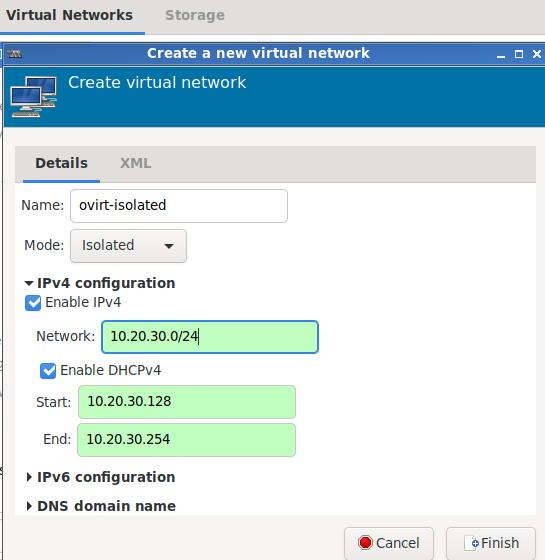
1.3 VMs Preparation
I use 3 vms for setting up the environment, each of them have:
2 vcpus
10240 MB memory
vda: 100 GB, for installing the system.
vdb: 300 GB, for setting up the storage network.
NIC: 1x, attached to ovirt-isolated networking.
hostname - IP is listed as following:
instance1.com 10.20.30.31
instance2.com 10.20.30.32
instance3.com 10.20.30.33
engineinstance.com 10.20.30.34
For setting up the ip address, use nmtui in terminal, take instance1.com for example:
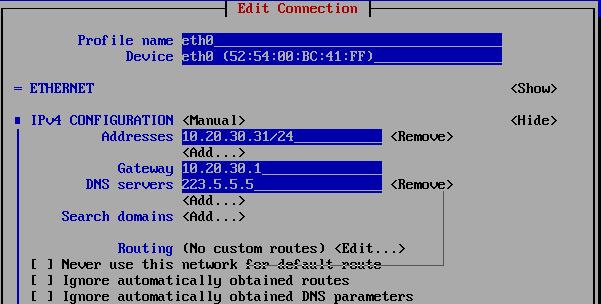
For setting up the hostname, also use nmtui:
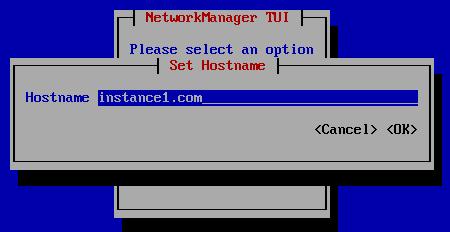
Login to each machine and enable the password-less login, take instance1 for example:
# ssh-keygen
# vim /etc/hosts
127.0.0.1 localhost localhost.localdomain localhost4 localhost4.localdomain4
::1 localhost localhost.localdomain localhost6 localhost6.localdomain6
10.20.30.31 instance1.com
10.20.30.32 instance2.com
10.20.30.33 instance3.com
10.20.30.34 engineinstance.com
# ssh-copy-id root@instance1.com
# ssh-copy-id root@instance2.com
# ssh-copy-id root@instance3.com
Also add following items(engine vm’s hostname and ip address) into host machine(archLinux)‘s /etc/hosts:
10.20.30.31 instance1.com
10.20.30.32 instance2.com
10.20.30.33 instance3.com
10.20.30.34 engineinstance.com
2. Deploy Glusterfs
Use firefox for visiting https://10.20.30.31:9090:
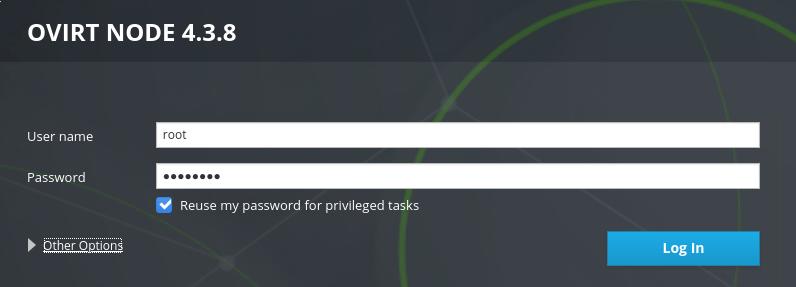
use root for login, enter the instance1.com's cockpit web:
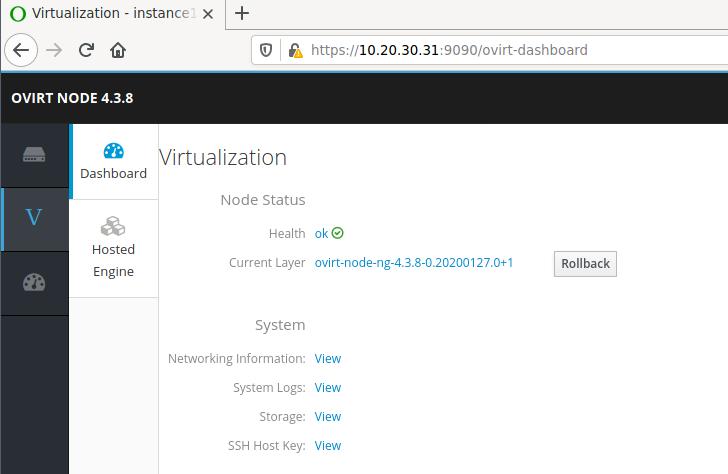
Click V->Hosted Engine, then click the start button under Hyperconverged:
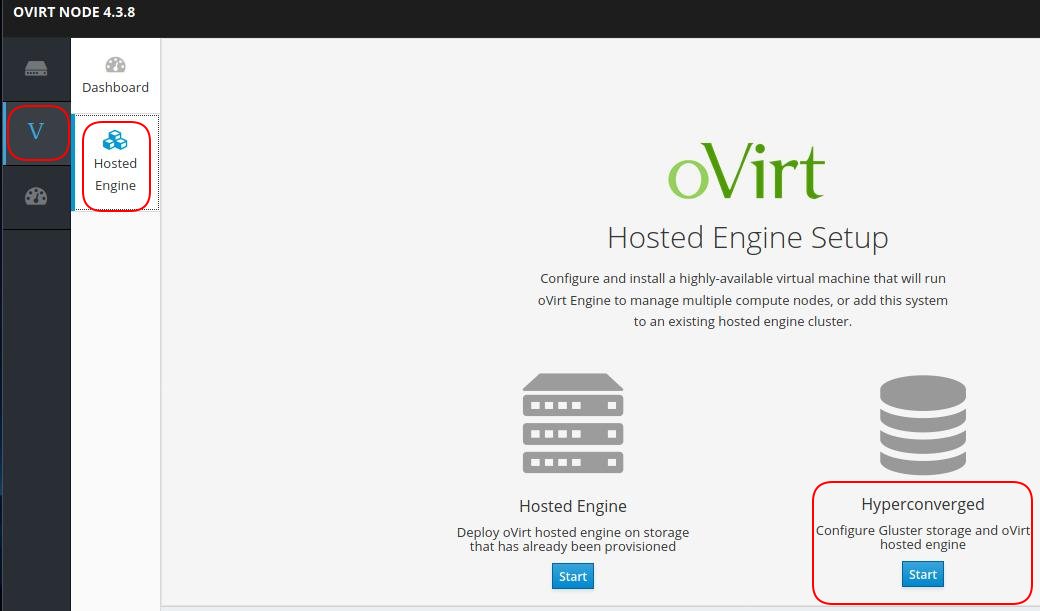
Click Run Gluster Wizard:

Fill in 3 nodes’s hostname, click next:
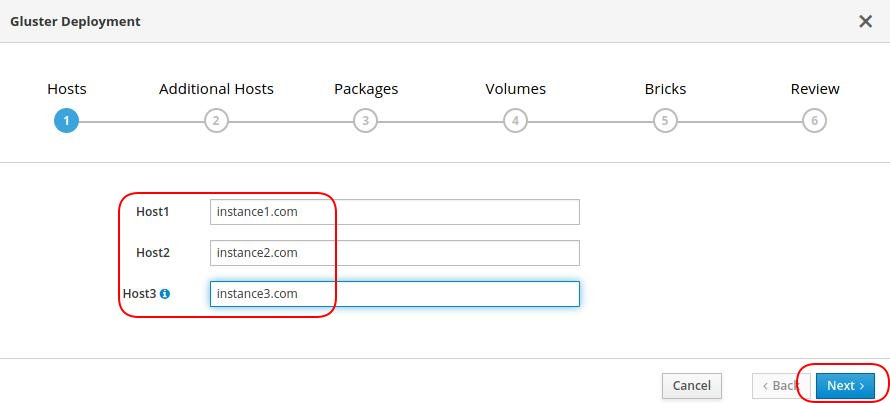
In Additional Hosts, click Use same hostnames as in previous step, thus Host2 and Hosts3 will be added automatically:
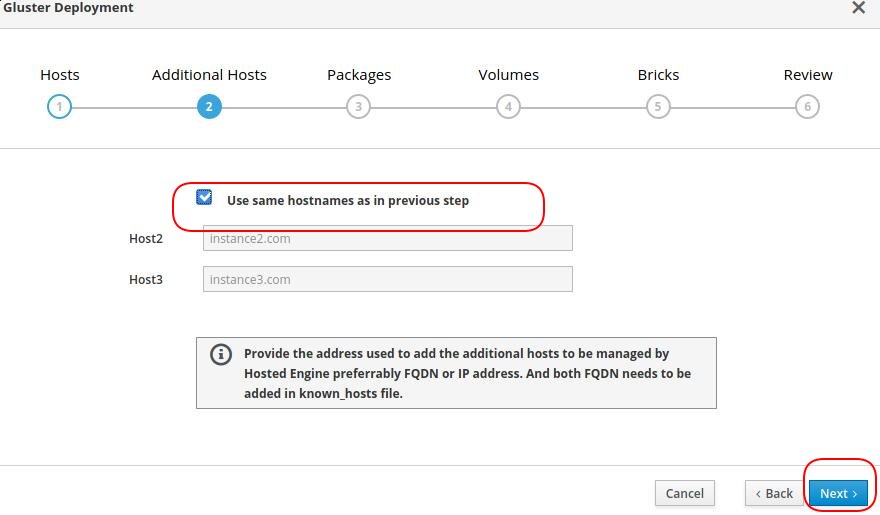
In Packages we keep the default empty items and click next for continue.
Keep the default volumn setting, and enable the Arbiter for data and vmstore:
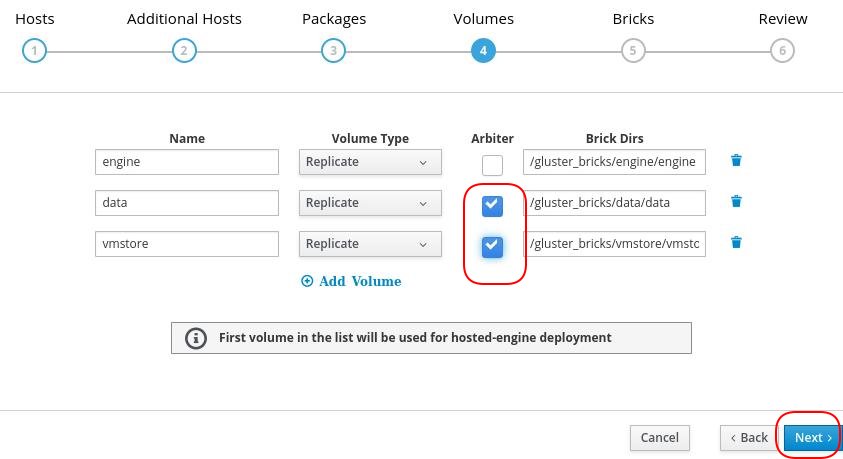
Here we adjust the LV device name to vdb, and adjust the size as 80,80,80, click next for continue:
The volume size for running engine vm should be at least 58GB(ovirt default minimum size, actually takes more than this number. )
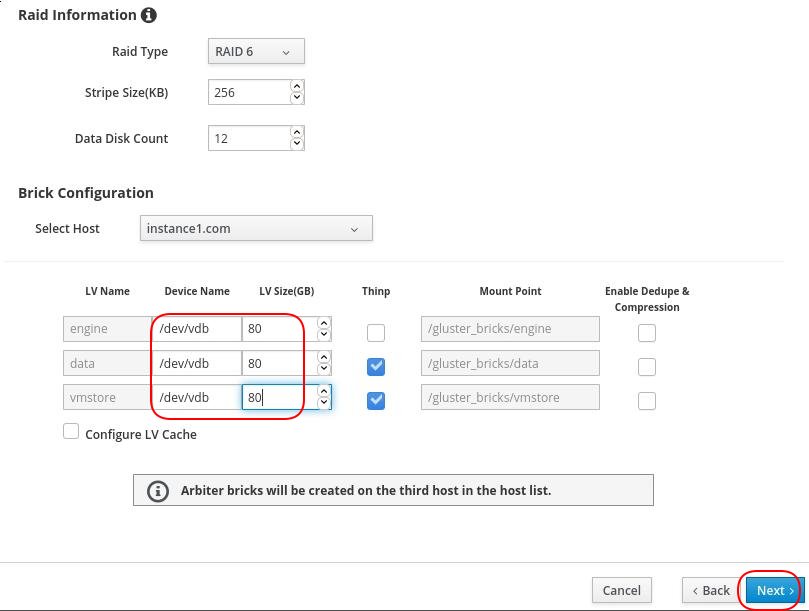
Review and click deploy:
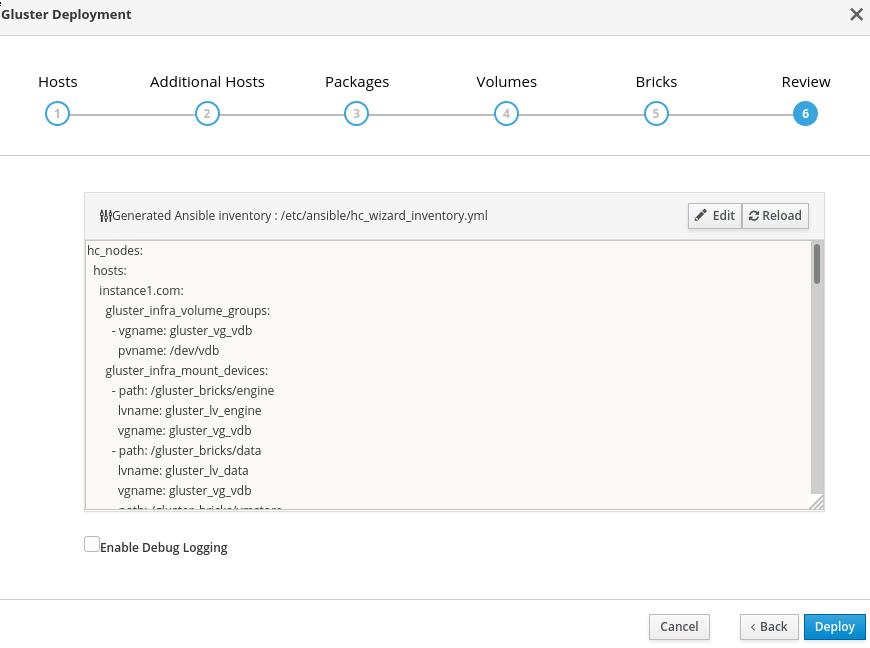
The ansible tasks will run until you see this hint:
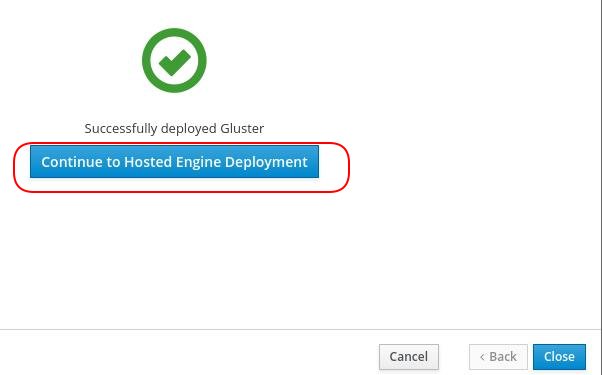
Click Continue to hosted engine deployment to continue.
3. Hosted Engine
Before continue, manually install the rpms in instance1.com:
# yum install -y ./ovirt-engine-appliance-4.3-20200127.1.el7.x86_64.rpm
# rpm -qa | grep ovirt-engine-appliance
ovirt-engine-appliance-4.3-20200127.1.el7.x86_64
Fill the engine vm’s configuration infos:
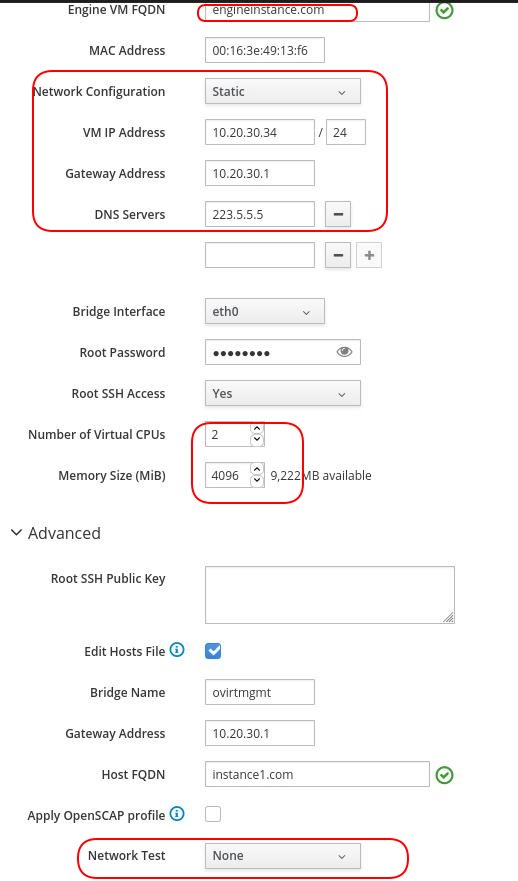
Fill in admin portal password(this password will be used in web login) and continue:
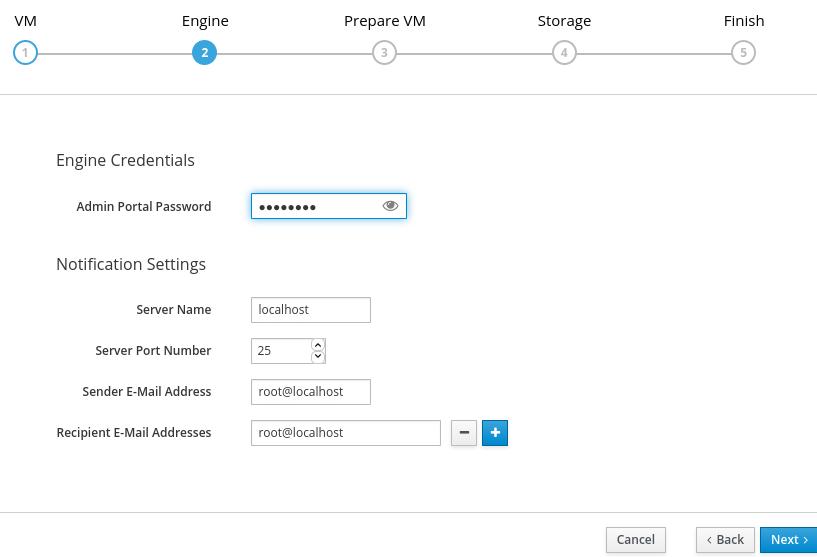
Examine the configuration and click Prepare VM:

Wait for about half an hour to see deployment successful:

Keep the default configuration:
engine vm’s storage configuration will use Gluster, path will be Gluster’s
engine volumn, and its parameter is:
backup-volfile-servers=instance2.com:instance3.com
for preventing the single-node issue for Gluster.
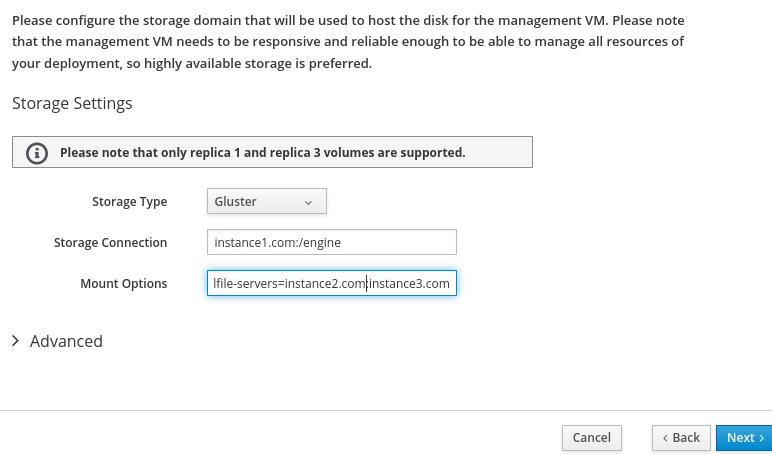
Click Finish deployment, and wait for a break:
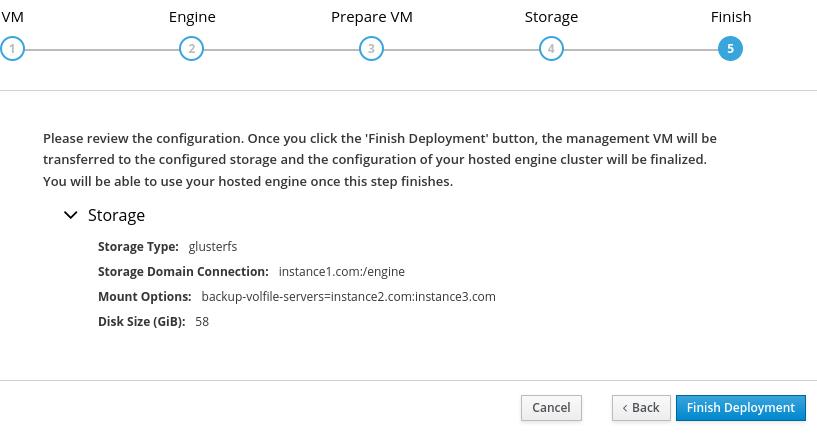
Seeing this means deploy succeeded:
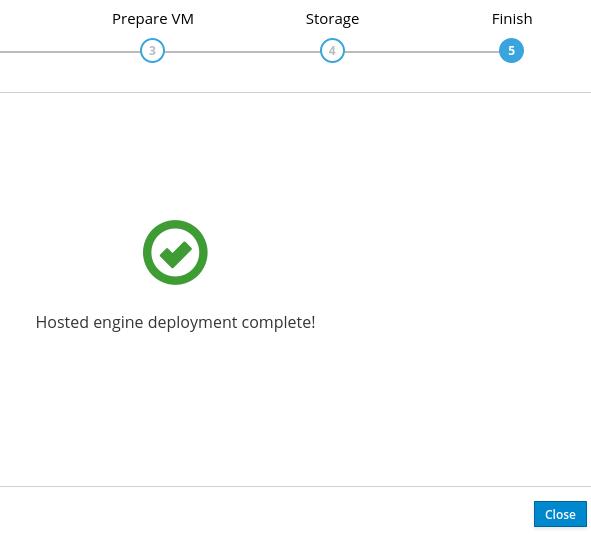
Refresh the status:
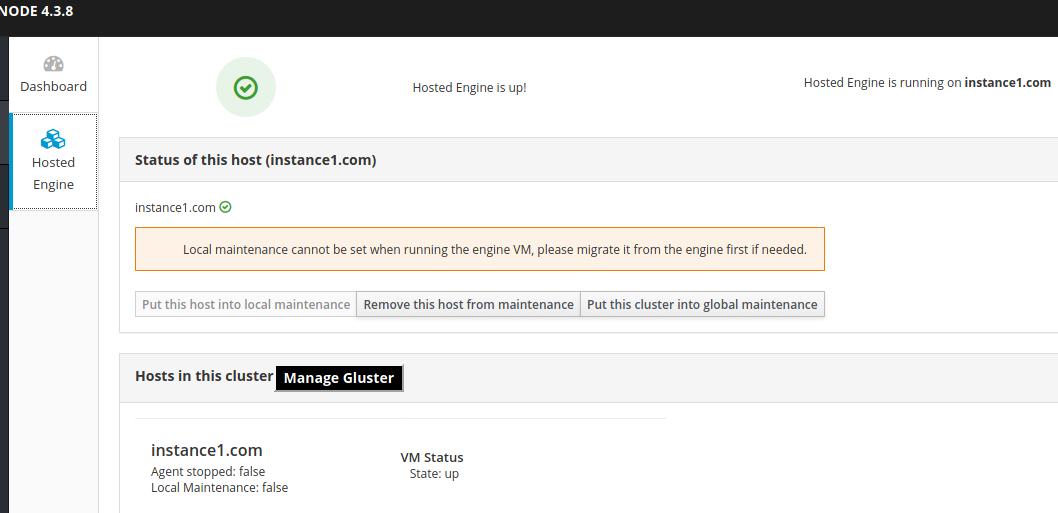
4. Portal
Visit engineinstance.com in host machine(ArchLinux):
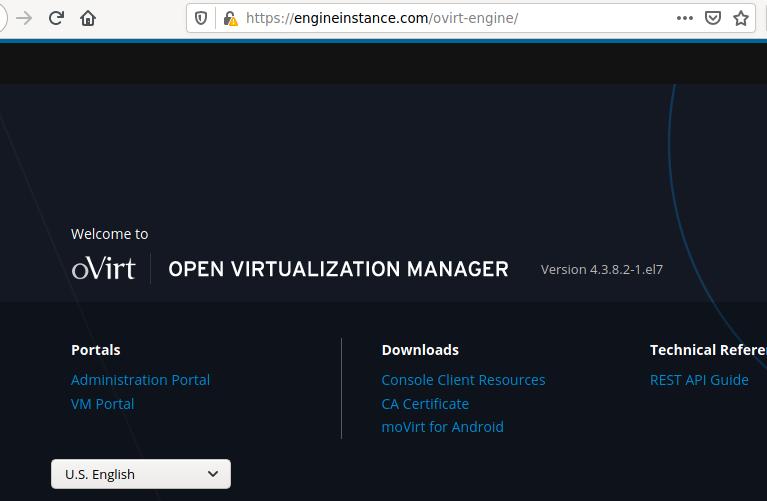
Click Administration Portal:
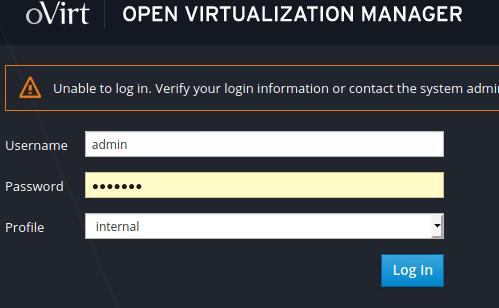
admin page is like following:
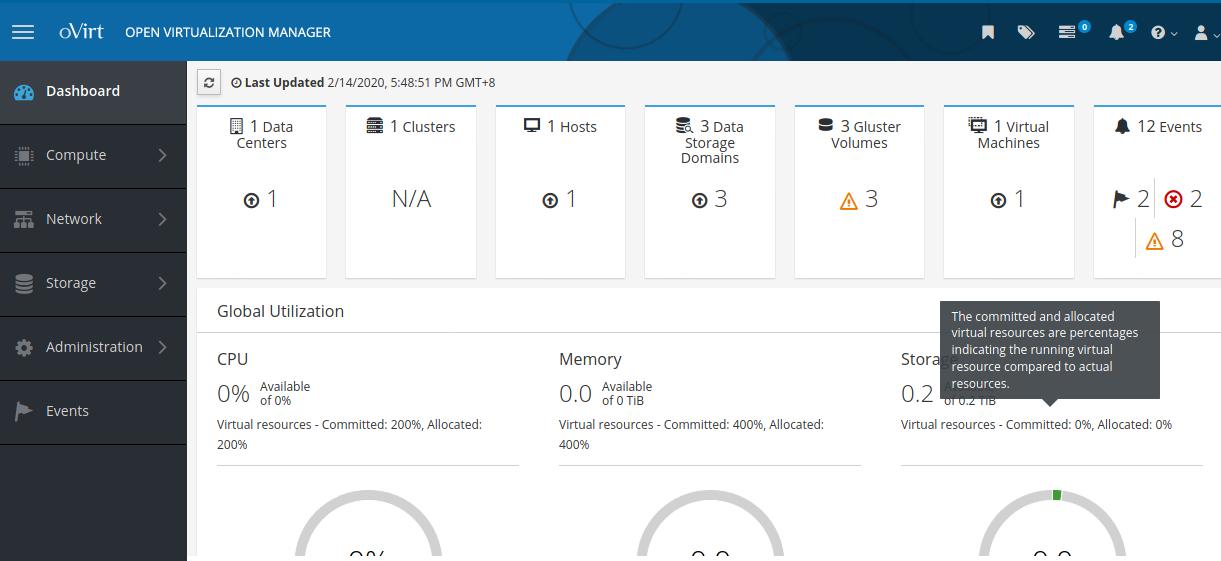
ssh into engine vm and check the disk partitions:
# ssh root@10.20.30.34
root@10.20.30.34's password:
Last login: Fri Feb 14 17:25:51 2020 from 192.168.1.1
[root@engineinstance ~]#df -h
Filesystem Size Used Avail Use% Mounted on
devtmpfs 1.9G 0 1.9G 0% /dev
tmpfs 1.9G 12K 1.9G 1% /dev/shm
tmpfs 1.9G 8.9M 1.9G 1% /run
tmpfs 1.9G 0 1.9G 0% /sys/fs/cgroup
/dev/mapper/ovirt-root 8.0G 2.3G 5.8G 29% /
/dev/mapper/ovirt-home 1014M 33M 982M 4% /home
/dev/mapper/ovirt-tmp 2.0G 33M 2.0G 2% /tmp
/dev/mapper/ovirt-var 20G 437M 20G 3% /var
/dev/vda1 1014M 157M 858M 16% /boot
/dev/mapper/ovirt-log 10G 45M 10G 1% /var/log
/dev/mapper/ovirt-audit 1014M 34M 981M 4% /var/log/audit
tmpfs 379M 0 379M 0% /run/user/0
5. Create The First VM
5.1 Add ISO storage Domain
Login in to instance1.com, configure nfs share storage for holding ISO
images:
[root@instance1 ]# mkdir -p /isoimages
[root@instance1 ]# chown 36:36 -R /isoimages/
[root@instance1 ]# chmod 0755 -R /isoimages/
[root@instance1 ]# vi /etc/exports
[root@instance1 ]# cat /etc/exports
/isoimages *(rw,sync,no_subtree_check,all_squash,anonuid=36,anongid=36)
[root@instance1 ]# systemctl enable --now nfs.service
Created symlink from /etc/systemd/system/multi-user.target.wants/nfs-server.service to /usr/lib/systemd/system/nfs-server.service.
In ovirt manager portal , click Storage->Storage Domain, click New Domain:

Fill in name and path information:
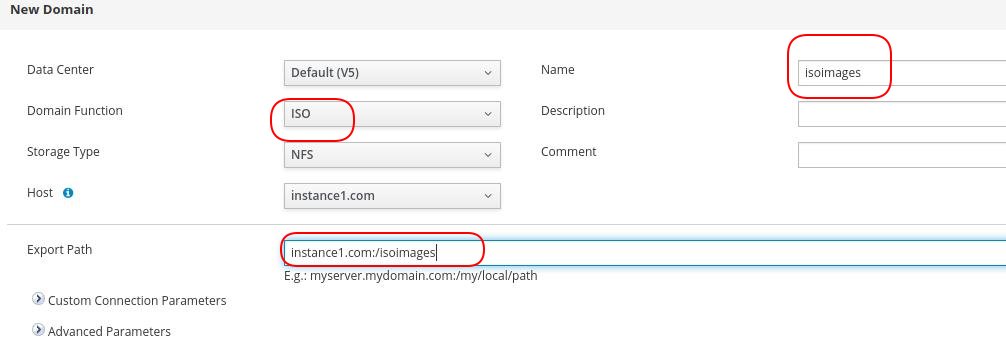
Finished adding isoimages:

5.2 Upload iso
Login to engien vm(engineinstance.com), download the iso from official site,
we take ubuntu16.04.6 for example:
[root@engineinstance ~]# ovirt-iso-uploader -i isoimages upload ./ubuntu-16.04.6-server-amd64.iso
Please provide the REST API password for the admin@internal oVirt Engine user (CTRL+D to abort):
Uploading, please wait...
INFO: Start uploading ./ubuntu-16.04.6-server-amd64.iso
Uploading: [########################################] 100%
INFO: ./ubuntu-16.04.6-server-amd64.iso uploaded successfully
5.3 Create VM
Compute-> Virtual Machines, click new button:
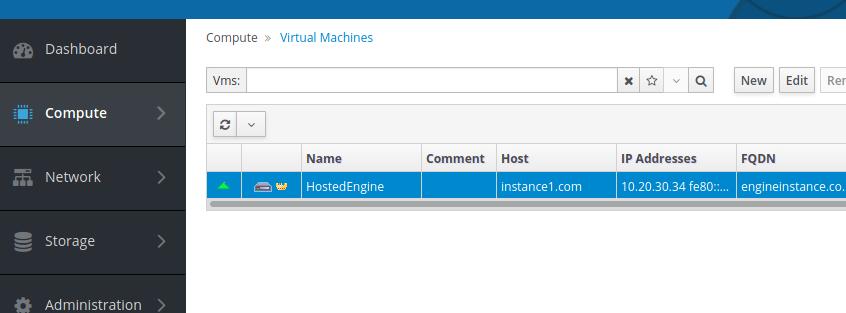 Fill in informations:
Fill in informations:
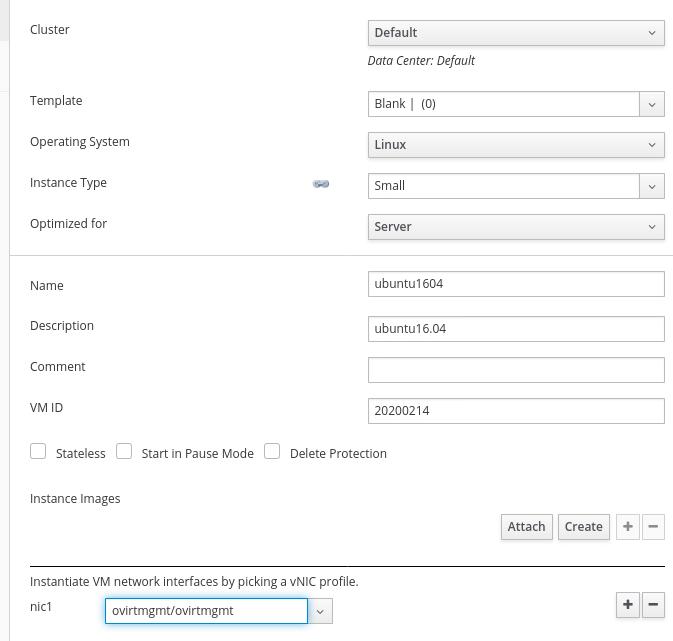
Click advanced options, select Boot Options, then attach uploaded iso:
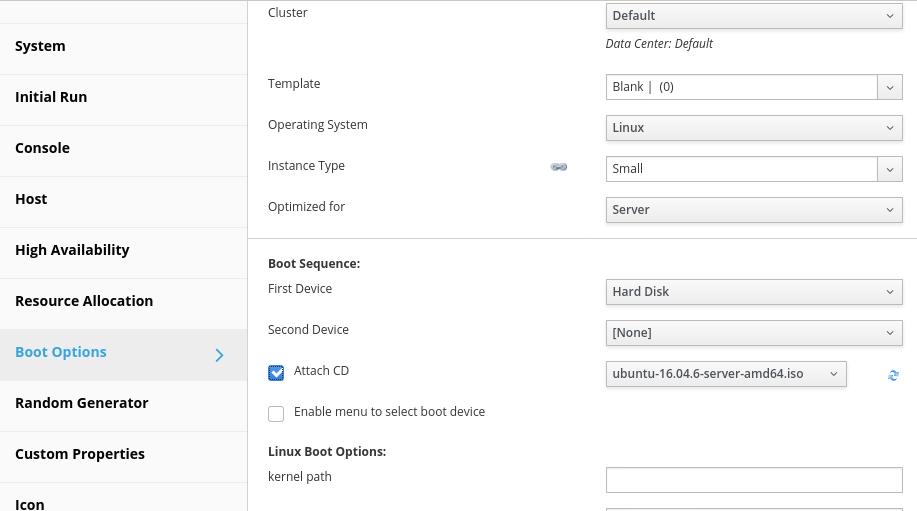
Click Disks, then click new:

Fill in options:
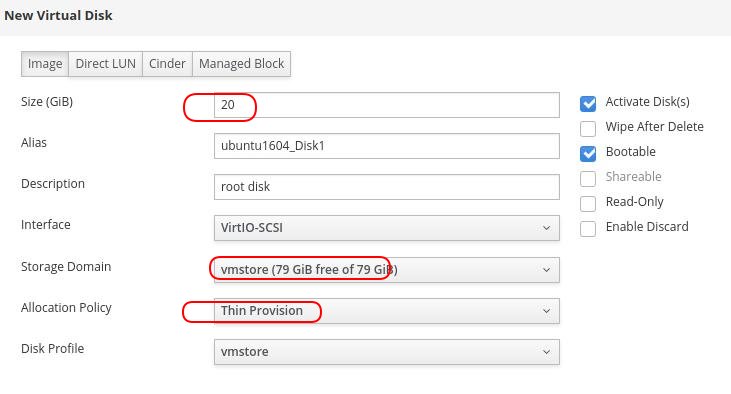
Click this new machine, and select run->run once:
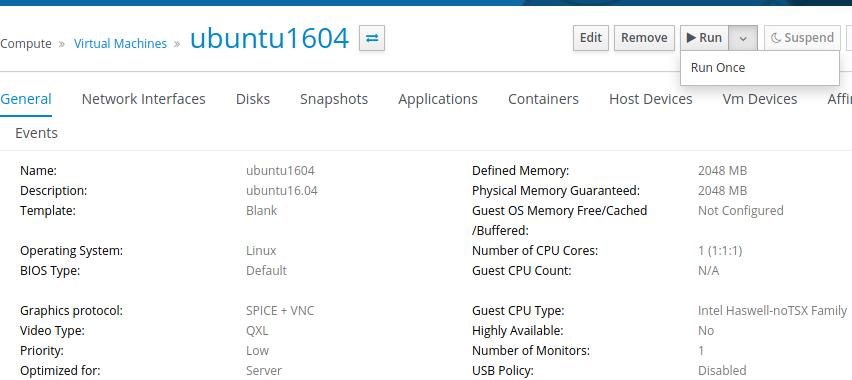
Click OK for installation:
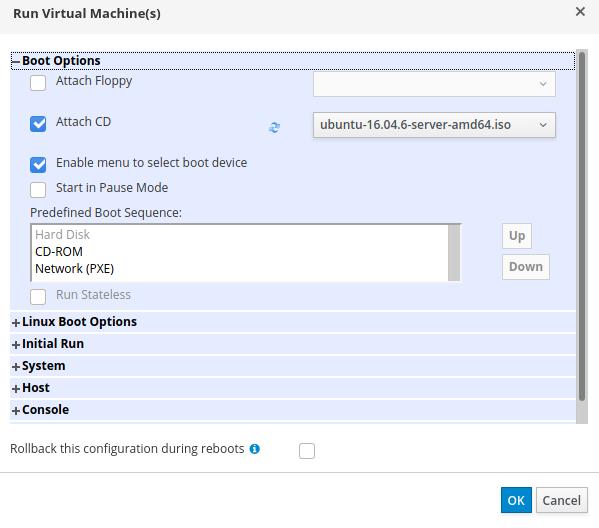
The installation image will be shown:
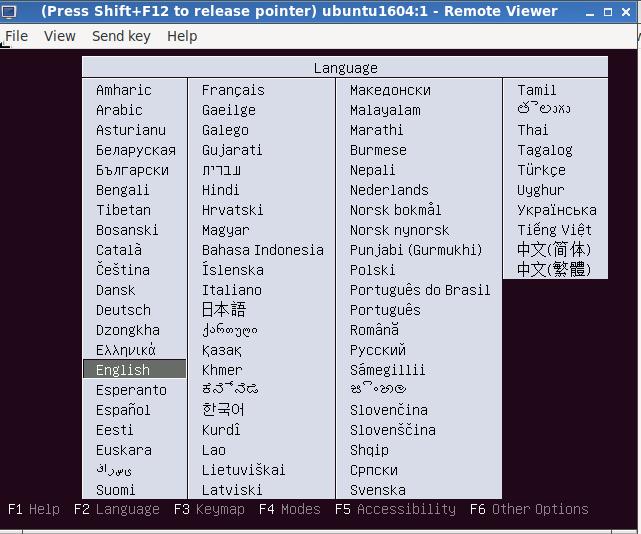
Configure installation options and wait until installation finished.
Since we use nested virtualization, the installation step will take a very
long time(>1h) for installing the os. For speedup, considering use NVME ssd
for locating the vm’s qcow2 files. Or use 3 physical servers.
On vm portal we could see our newly created vm:
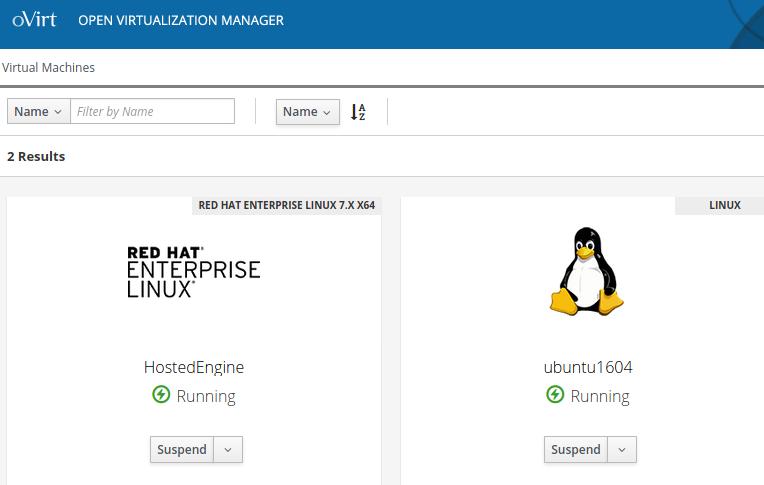
Examine the vms on instance1.com:
[root@instance1 isoimages]# virsh -r list
Id Name State
----------------------------------------------------
2 HostedEngine running
4 ubuntu1604 running
6. Create vm using template
6.1 Create template
Create template via:
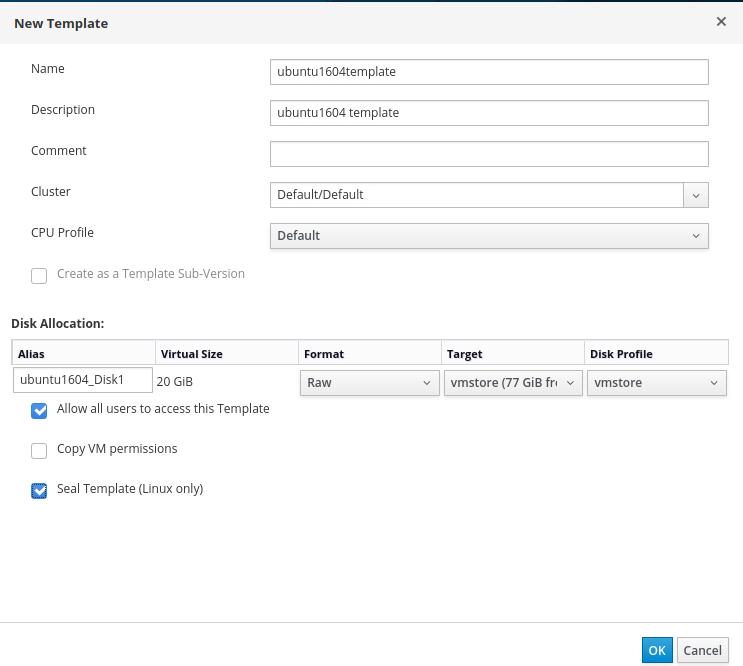
Check the status of template:

6.2 Create vm
Create new vm using template:
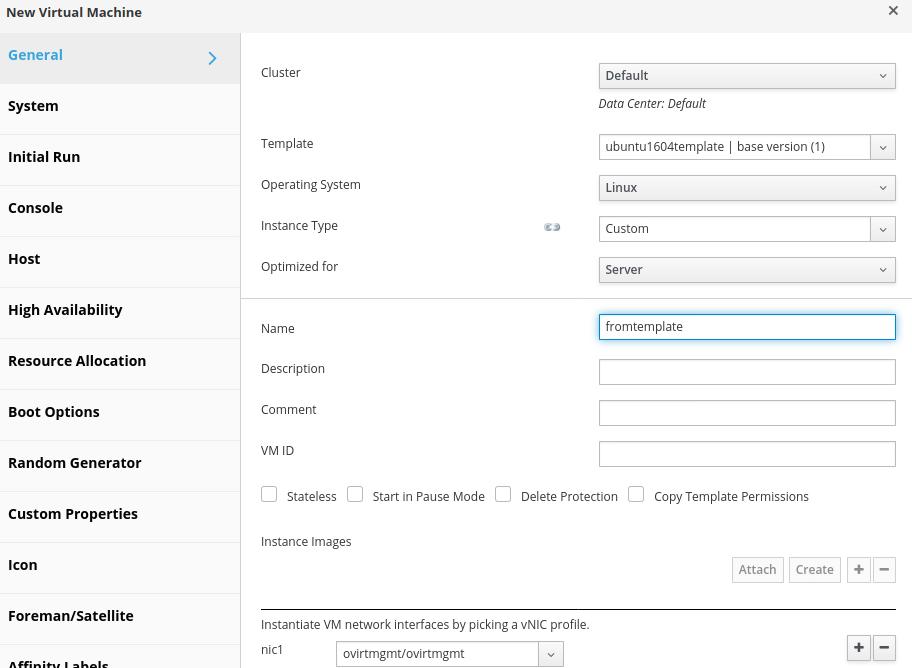
Start the machine and check result:

7. Add hosts
In engine vm, add following items:
Then we add hosts of instance2.com and instance3.com:
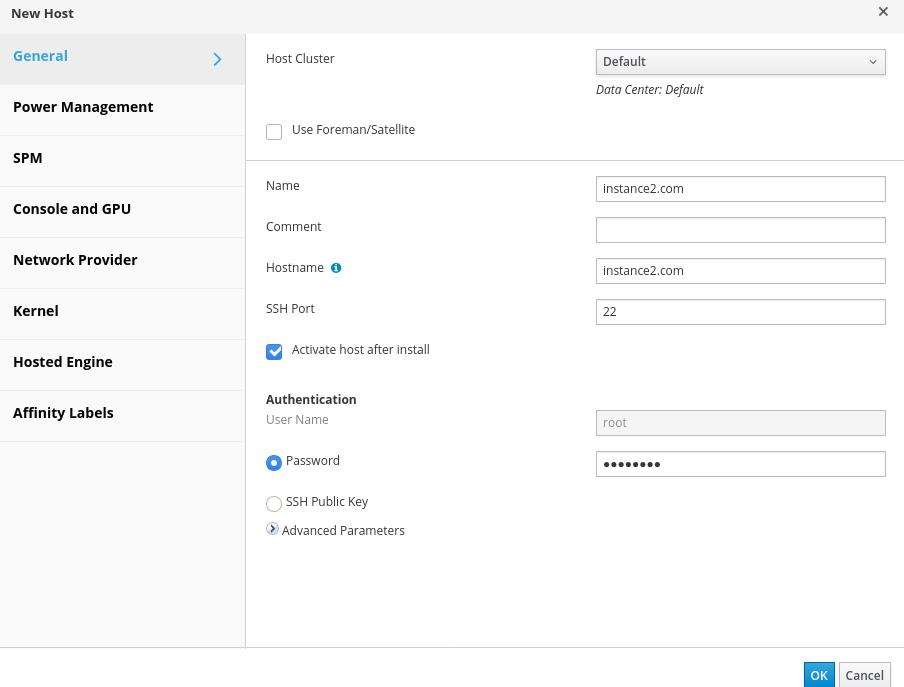
Result:

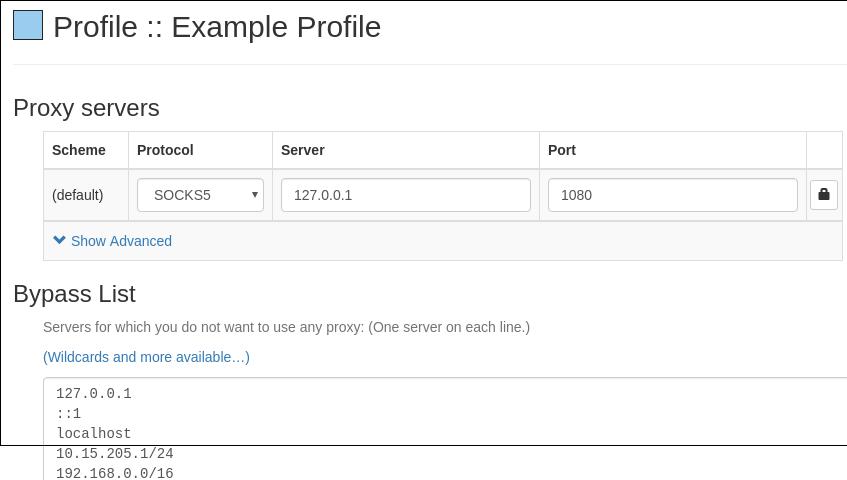
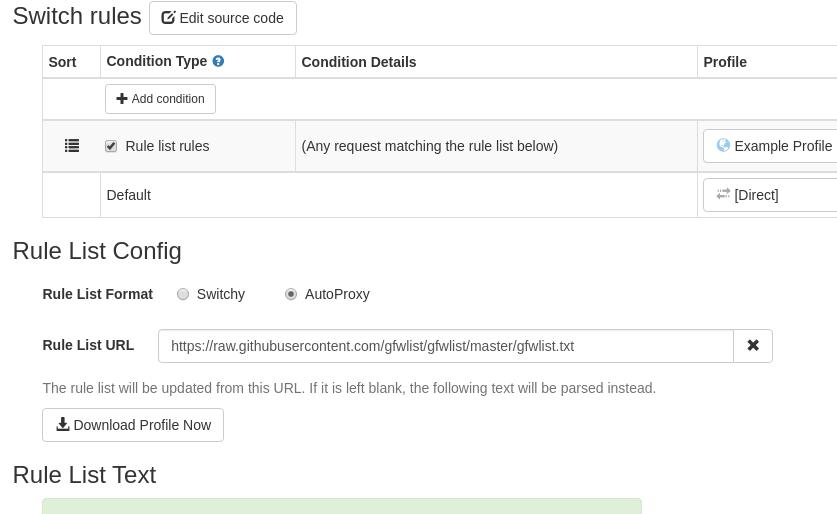

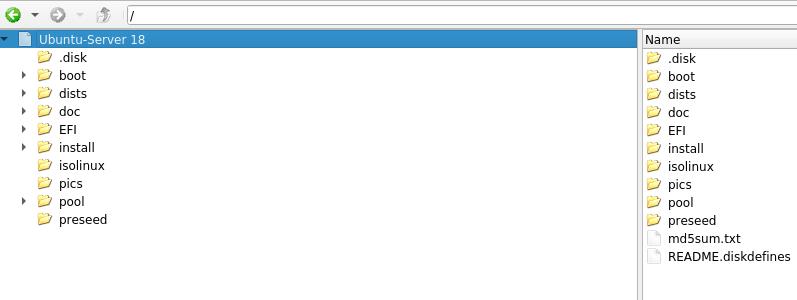
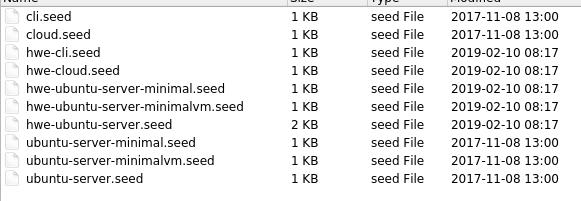
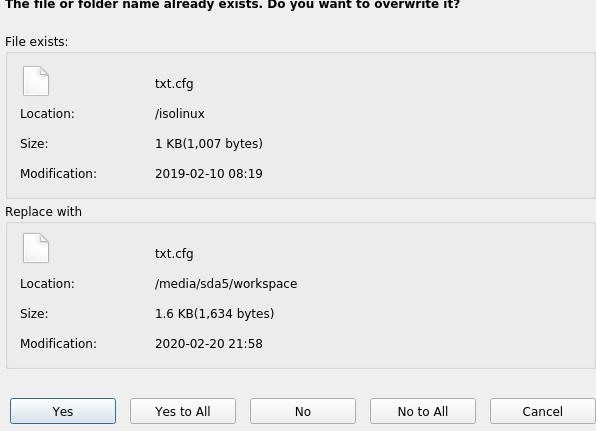
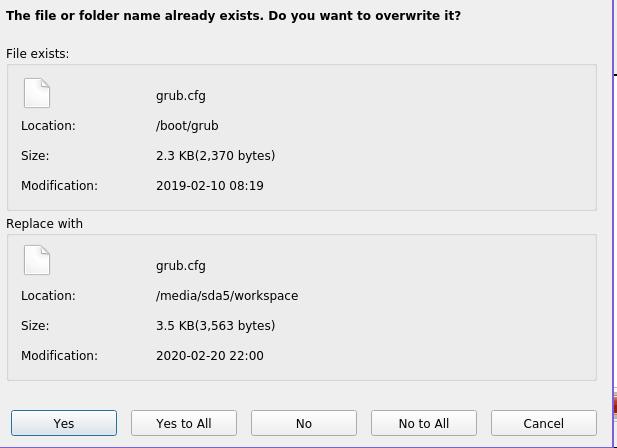
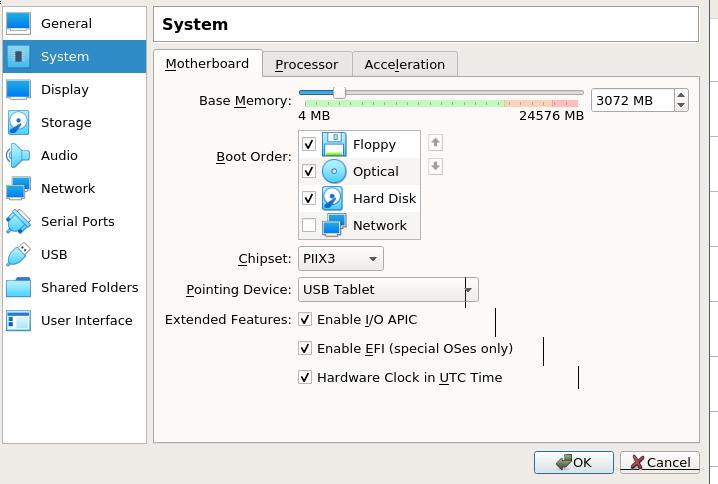
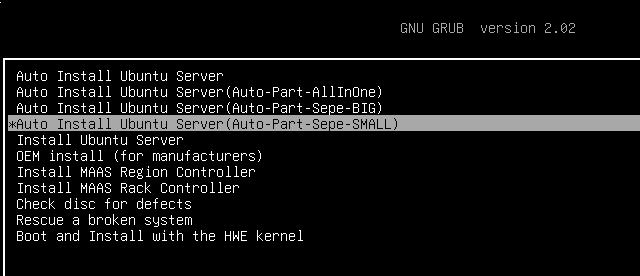
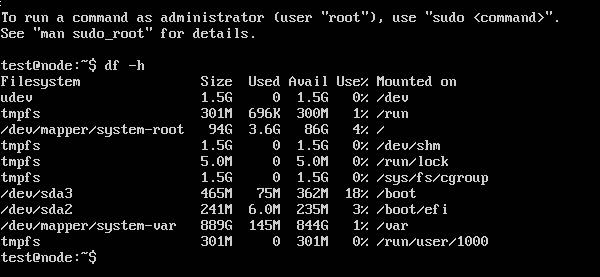


























 Fill in informations:
Fill in informations:












